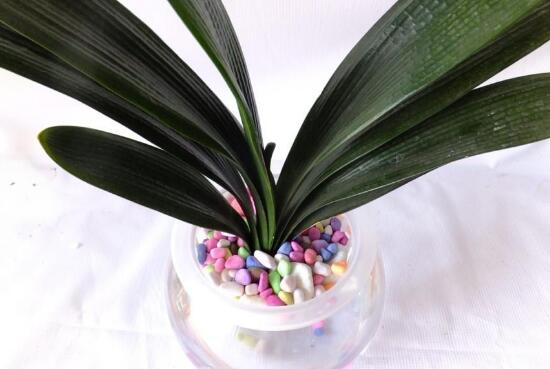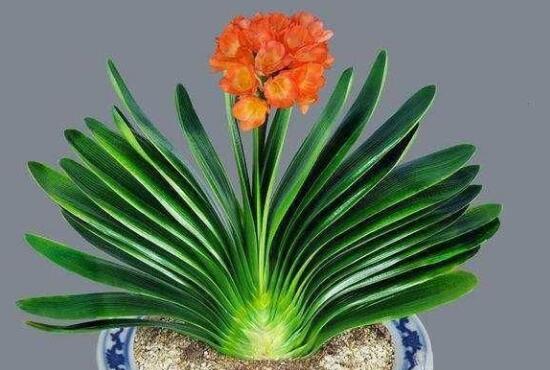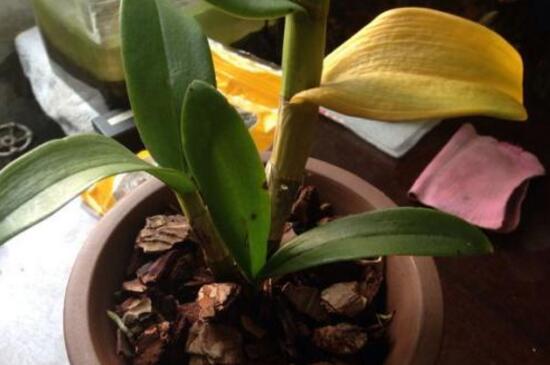Can Cymbidium be cultured in water? the method of hydroponics / change the water every three to five days.
Since ancient times, the gentleman orchid is the favorite object of the people, its leaves are fat and green, the flowers are bright and beautiful, and it is kept at home by many people. Most flower friends raise orchids are cultivated in soil, but compared with soil culture, hydroponics look cleaner and easier to raise, so can orchids be hydroponically cultivated? Today, the editor will introduce to you how to cultivate magnolia in water.
Can the magnolia be hydroponically cultivated? yes

According to the editor, magnolia likes plants in a humid environment and can withstand shade and low temperature, so can orchids be hydroponically cultivated? Obviously, it can, and compared with common soil cultivation, hydroponics will be clean and simple, easy to operate and manage, as long as you keep sufficient light, suitable temperature and clean water.
Second, the method of hydroponic cultivation of Magnolia.
(1) preparation before hydroponics
1. Container selection
Before we know the method of hydroponic culture, we should first do the preparatory work, such as selecting a hydroponic container. Generally speaking, for indoor hydroponics, it is best to choose a transparent glass container, so that it is not only good-looking, but also easy to observe its growth; in addition, if you raise a seedling, you only need a glass can.
2. Nutrient solution
For the healthy growth of plants, nutrient solution is indispensable, while hydroponic orchids generally use both inorganic and organic. Among them, the organic fertilizer is rich in composition, but the nutrient content is not high, so it can be applied once every 5 days; the composition of inorganic fertilizer is relatively simple, but the fertilizer effect is large, and the effect is fast, so it needs to be applied once a week. However, in order to learn from each other's strengths and make up for their weaknesses, we can combine the two.
3. Use trapped water
In hydroponics, it is best to use trapped water, that is, tap water that has been exposed to the sun for 3-5 years. This is because the tap water contains chlorides such as bleach, which can cause damage to the roots of the orchid, but they will precipitate after exposure to the sun. After the trapping water is changed, the position of the submerged root must not submerge the false bulb, but it is not difficult to be too shallow.
(2) hydroponic culture method
After making the above preparations, we can officially cultivate the magnolia in water. Take 2-3 years of strong growth of Cymbidium, wash the roots, soak in potassium permanganate solution for 10 minutes, and then rinse with clean water. After that, it is raised with tap water that does not exceed 1/5 of the root system, and the water is changed every three days or so.
Before hydroponics, we must pay attention to pruning the rotten roots and old roots of Cymbidium. After 10-15 days, new roots can sprout at the base of the pseudobulbs, and water is added to 1 beat 2 to 1 beat 3 without passing the root system; when the new roots grow to about 5 cm, they are cultivated in nutrient solution. After flowering, cutting off the residual flowers and spraying potassium dihydrogen phosphate solution can enrich the plant development and promote the differentiation of flower buds.
(3) points for attention in hydroponic culture of Magnolia.
1. Oxygen
In the process of hydroponic cultivation of magnolia, there are several important points, one of which is to always check whether there is enough oxygen in the water. Method: like putting a small fish in a hydroponic container, if it is all right, there is no lack of oxygen in the water, and vice versa. When it is found that there is a lack of oxygen in the water, there are two ways to replenish oxygen, one is to change the water, and the other is to supply oxygen to the water with a small oxygen pump.
2. Lighting
Magnolia is a semi-yin-yang plant, even if it is hydroponic, it also needs light. In summer, however, it is necessary to avoid the strong direct sunlight and expose it to scattered light. In addition, the leaves of Cymbidium have the characteristics of directional light, so in order to make the leaves receive light evenly, we should adjust the illumination angle every two or three days.
3. Temperature
For hydroponic cultivation, the room temperature of adult plants should be kept at 11-25 ℃, and the seedlings should be slightly higher, 20-35 ℃. The temperature difference between day and night should be mastered in orchid cultivation in water, which should be kept at about 20 ℃ during the day and not less than 15 ℃ at night in winter.
How to cultivate Cymbidium by hydroponics? the method of hydroponics
Recently, Cymbidium is widely loved by everyone, and it is highly ornamental. Cymbidium likes to live in a humid environment and cannot be exposed to high temperature. Summer has come, with the rising temperature, how to maintain the magnolia? Many friends have adopted the method of water culture, but if the method of water culture is not in place, it will also raise a gentleman's orchid. How to hydroponically cultivate Cymbidium? the following editor introduces the hydroponic method of Cymbidium.
The method of hydroponic culture of Cymbidium
In hydroponic cultivation, tap water cannot be used directly, but "trapped" water must be used. The so-called "trapped" water means putting tap water in a container and drying it in the sun for five days to precipitate chlorides such as bleach that are harmful to the roots of the orchid. The "trapped" water, from the outside, the sediment changes from strips to lumps, and the color of the water is green. After "trapping" good water, the position of the submerged root must not submerge the false bulb. If the water level is too shallow, the magnolia can not get sufficient water supply, and if the water level is too deep (flooding the false bulb), it will cause root fester.
In the process of breeding, we should pay more attention to observe the changes of water quality, and find that some roots turn yellow or black, indicating that the water is both anoxic and less fertile, and the water must be changed immediately. Whether the air, sunlight and temperature can deal with the ventilation of the roots of hydroponic orchid is the key to the success or failure of hydroponics. After a period of culture, there is a layer of moss on the root. When the moss is too thick, it will seriously affect the respiration of the root and corrode the culture medium. At this time, you need to gently brush off the moss layer with a soft and clean brush (you don't have to brush it clean, because a small amount of moss at the root has little effect).
In addition, always check whether there is enough oxygen in the water. The method of inspection is to put two or three small fish into the water culture box. If the small fish swim freely in the water, it means that there is no lack of oxygen in the water. If the small fish always float to the surface, their mouths and gills are exposed to the surface to breathe, which means there is no oxygen in the water. It is found that after anoxia in the water, oxygen must be replenished. There are two methods: one is to change the water, and the other is to supply oxygen to the water with a small oxygen pump. In the treatment of sunlight, magnolia is a semi-yin-yang plant, we should pay attention to the light, especially in summer, to avoid the strong direct sunlight, so that it can receive scattered light.
In addition, according to the light-oriented characteristics of Cymbidium leaves, we should pay attention to make the leaves receive light evenly, otherwise the leaf length will be different, the growth direction will be scattered back and forth, and the illumination angle should be adjusted every two or three days. In terms of temperature treatment, the ambient temperature of adult Cymbidium should be 11 ℃-25 ℃, and the seedlings can be slightly higher, 20 ℃-35 ℃. The temperature difference between day and night should be mastered in orchid cultivation in water, which should be kept at about 20 ℃ during the day and not less than 15 ℃ at night in winter.
Container selection: for the hydroponic culture of Cymbidium, be sure to choose a good container. Generally speaking, it is better to use a transparent glass container. If you raise a seedling, you only need a glass can. If you want to plant a lot of water, you can use fine wire to compile a metal mesh with a diameter of one centimeter, and make a glass hydroponic box slightly smaller than the metal mesh, or you can use a goldfish tank instead. Then the metal net was covered on the hydroponic box, and the seedlings of Cymbidium were inserted into the nutrient solution through the mesh, and the depth of the flower root in the culture medium did not exceed the limit of the false bulb of the root.
The preparation of nutrient solution can be divided into inorganic and organic. The inorganic nutrient solution can be prepared in the following proportion: 1.5g of calcium, 0.01g of ferrous sulfate, 1g of urea, 1g of potassium dihydrogen phosphate and 0.5g of magnesium sulfate. After the above five inorganic salts are mixed together, they can be dissolved in 1000 grams of water. The organic culture solution was prepared as follows: fried flax seed flour 100g, bone powder (made of salt-free fresh bone) 100g, bean cake powder 150g, cooked sesame powder 50g, and then dissolved in 1000 grams of water. Compared with the above two kinds of nutrient solution, the composition of organic fertilizer is rich, but the nutrient content is not high, and the composition of inorganic fertilizer is relatively simple, but the fertilizer effect is high and the effect is fast. In order to learn from each other's strong points to offset their weaknesses, the two can be used together. If used alone, inorganic fertilizer is applied once a week, and organic fertilizer is applied once every 5 days.
In the conservation of orchids, we must pay attention to temperature, humidity and water supply, so that orchids grow in a good environment. The above is the method of hydroponics and hydroponics introduced by Xiaobian. I hope the sharing of Xiaobian will be helpful to everyone.
The method of hydroponic Culture of Magnolia
The method of hydroponic Culture of Magnolia
1. Wash the roots of 2-3-year-old Cymbidium, soak them in potassium permanganate solution for 10 minutes, then rinse them with clean water, raise them with tap water less than 1/5 of the root system, and change the water once every three days.
2. Pay attention to pruning rotten roots and old roots. New roots can germinate at the base of the false bulb for 10-15 days, add water to 1/2 to 1/3 of the root system, and grow to about 5 cm.
3. After flowering, cutting off the residual flowers and spraying potassium dihydrogen phosphate solution can enrich the plant development and promote the differentiation of flower buds.
Ecological habits of Cymbidium
Like the warm winter and cool summer environment, avoid bright light, summer should be shaded. The flowering period can be prolonged by half a month under low temperature and low light. It grows at room temperature of 15-25 degrees Celsius and can withstand a low temperature of zero degrees Celsius.
Placement position
Often placed in the living room and study, it has the demeanor of a gentleman and a general.
Fancy language
Miss, noble, have the demeanor of a gentleman.
- Prev

How to fertilize the orchid, how to fertilize the magnolia, how to fertilize the magnolia, how to fertilize the orchid, how to fertilize the magnolia, how to fertilize the orchid.
As the saying goes, a good crop with a flower depends entirely on fertilizer. If you want a gentleman's orchid to grow well, fertilization is very important. In life, there are many flower friends who raise magnolia, and many of them watered it a lot of things, including eggs, in order to grow better. It is said that Cymbidium grows rapidly with eggs for fertilization.
- Next

How to do the yellow leaves of potted Dendrobium officinale? Change the pot soil to control watering/proper shade.
As one of the most useful Dendrobium species, Dendrobium officinale has strong efficacy. It not only flowers beautifully, but also inherits the medicinal value of Dendrobium officinale, which can treat various diseases of human body. However, in the breeding process, many flower friends often encounter a problem, that is, yellowing leaves.
Related
- Fuxing push coffee new agricultural production and marketing class: lack of small-scale processing plants
- Jujube rice field leisure farm deep ploughing Yilan for five years to create a space for organic food and play
- Nongyu Farm-A trial of organic papaya for brave women with advanced technology
- Four points for attention in the prevention and control of diseases and insect pests of edible fungi
- How to add nutrient solution to Edible Fungi
- Is there any good way to control edible fungus mites?
- Open Inoculation Technology of Edible Fungi
- Is there any clever way to use fertilizer for edible fungus in winter?
- What agents are used to kill the pathogens of edible fungi in the mushroom shed?
- Rapid drying of Edible Fungi

